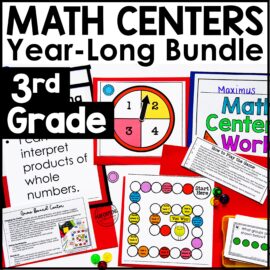Math centers are one of my favorite things to use in my classroom, but it hasn’t always been that way. They were overwhelming to me when I started teaching because I couldn’t figure out how to create so much content. I struggled to organize my students and know how to use the content to differentiate for them. It seemed like a lot of work compared to direct instruction.
Consistency is really important at the beginning of the school year. I always make sure my math centers are the same types of centers so students know what to do. I swap out the content, but it’s the same type of center. This way, when you get into important content later and want to do more small groups, students will already know what to do and they can start and work independently.
Here’s exactly what I use in my math centers.
Center #1: Board Games

I print out a board game and laminate it. I’ll often print out five or six different game boards so I can swap them out. This way, they look a little different, have different numbers of spaces, and have different instructions. It will be different enough to keep students engaged but still similar enough for them to know how to use it. Game boards are really easy to find on Teachers Pay Teachers.
From here, you can use things like task cards or practice problems from worksheets. I also have problems included in a free Math Center Resource you can download here. It’s easy to pop in a bunch of problems, put in some dice, and say, “when you get it right, roll the dice, move your spaces, and see who wins.” It’s really simple to use and versatile. They can play as a group or with partners. It’s a simple way to keep a group of students engaged without spending much time planning or prepping.
Center #2: Secret Picture Tiles

The Secret Picture Tile center is one of my students’ favorites because they can’t wait to figure out what the picture is. First, I take a picture and set it up into grids. Then, I put problems and answers on it. Finally, we cut it and mix everything up. To figure out what the picture looks like, they must match the corresponding problem to the correct answer.
This is also great because it’s self-checking. You can have students work on this individually or in groups. You can plan and prep these in a couple of different ways.
- Laminate everything – This takes a little extra time because you need to laminate and cut. Then, you put it in a baggie in your filing cabinet and use it yearly.
- Print out the pieces and have students cut and past them – This is a lot easier as far as prep goes.
It takes a little time to come up with your own problems, but if you use it year after year, it’s worth it. After a couple of weeks of doing this, your students will know exactly how to do the center and be engaged.
Center #3: Task Cards

You’ll like Center #3 because you probably already have a bunch of these—task cards. You can use task cards in a lot of different ways. A few ideas include
- Playing task card war (like they would with a deck of cards)
- Putting a task card in the middle and then use whiteboards to show their answers and compete
- Filling in a recording sheet and completing every single task card
This is a really versatile center because there are lots of ways you can use it and it’s easy to get task cards already made.
Center #4: Square Puzzles

Square puzzles are slightly different from Secret Picture Tiles but use a similar setup. Square puzzles allow students to complete a variety of problems and match the problems with the answers on the square next to them. If you’ve seen any book with math puzzles, you’ll see something like this.
Square puzzles allow students to work their brains a little extra. It’s also fun to solve problems and get the pictures lined up. In addition, it’s a little different, so they’re getting a different experience in this center but using the same skill.
Center #5: Error Analysis

I love to use Error Analysis centers in small groups. I don’t have my students sit down and complete these on their own because they create so much good discussion around math skills. They are looking to see different student work and what errors were made. You can often find error analysis task cards, or you can pull from errors you’ve seen in student work without using their names.
I love hearing the math discussions where students argue which part is wrong and which parts are correct. It’s very engaging and high in discussions.
Those are the math centers I use. I have all of them premade for multiple grade levels and skill levels. You can pick them up here. I find these to be so valuable for my classroom and other classrooms. I constantly get questions about these. You can even download a free math center resource to try it out in your class to see how they work.
Please share with me in the comments where you struggle with math centers. Is it the content? Is it the setup? Or is it behavior management? Let me know where you struggle so I know what math center information I should share in upcoming blog posts and videos.


